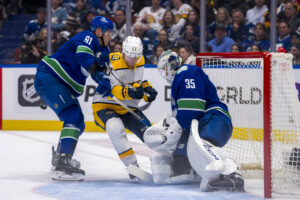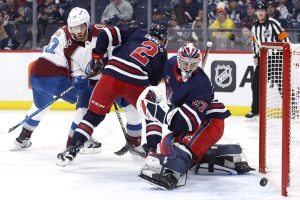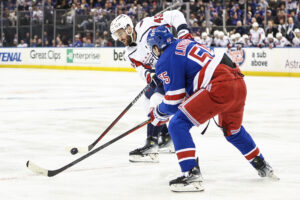Player development seems to always result in more questions than answers. How likely is it for a top pick to pan out? What makes a player a “steal”? Last Word On Hockey will be starting a new series on how to properly develop prospects from all different spots throughout the draft. This week’s piece involves top-10 picks and how they were used early in their careers.
Player Developments of Top 10 Picks
In the span of 2005 through 2015, there were 40 total selections made between fourth overall and tenth overall on forwards playing in North America. Of those 40 selections, three players were deemed not close to being NHL-ready after one additional season outside of the NHL following the draft. Those players were Bo Horvat, Pavel Zacha, and Jake Virtanen.
Player Development of Bo Horvat
Horvat, drafted ninth overall in the 2013 NHL Draft by the Vancouver Canucks, currently wears the “C” for Vancouver to this day. It all started in his DY-1 season with the London Knights of the OHL. That season, he scored 11 goals and 19 assists for 30 points in 64 games, resulting in a 0.469 point-per-game pace. That ranked 36th out of those aforementioned 40 forwards. He followed that up in his DY by scoring 33 goals and 28 assists for 61 points in 67 games, good for 0.91 points per game. That ranked 39th. It was clear Horvat was not quite ready, so the Canucks gave him one more season in the OHL.
In his DY+1 season, Horvat, now an assistant captain with London, scored 30 goals and 44 assists for 74 points in 54 games. That led to his best production in juniors yet, with a points per game pace of 1.37, ranking 16th out of the remaining 30 forwards yet to make an NHL roster in their DY+1 season. He would make the Canucks roster the following season.
How was Horvat used?
Playing 68 NHL games and five AHL games, Horvat was clearly given a big opportunity to impress right out the gates. In his five AHL contests, he failed to record a single point. In his 68 NHL games, however, Horvat would produce 13 goals and 12 assists for 25 points, finishing 11th in Calder trophy votes, per Hockey-Reference. He did that while averaging 12:16 of ice time per game. Horvat did not play well, however, according to analytics. His even-strength offense goals above replacement (EVO) was the only analytic above replacement level (2.6). Horvat’s even-strength defense goals above replacement (EVD), wins above replacement (WAR) and goals above replacement (GAR) were all in the negatives. His EVD was at -4.4, his WAR was down at -0.5 and his GAR, despite the solid EVO, was down at -2.7.
In his second pro season, Horvat would play all 82 NHL games, recording 16 goals and 24 assists for 40 points. That came in an average of 17:08. That shows that, despite the analytical struggles, Vancouver wanted to give Horvat an even bigger role to truly showcase his skills. His analytics still were not pretty, despite the raw stats taking a step forward. His EVO (6.4) improved, but his EVD remained negative (-4.3). Because of his struggles in the defensive end, his WAR was still below replacement level (-0.1). Again, despite his counting stats and EVO being solid, he still had a negative GAR (-0.4). Will he finally get over his analytical hump in year three?
Horvat finds his stride
In this third NHL season with the Canucks, Horvat would play 81 games, scoring 20 goals and 32 assists for 52 points. He would continue his rise in counting stats year-by-year with this performance, averaging a new high of 18:02 time on ice per game. His analytics would finally reflect that of a solid NHLer, with an EVO of 7.1 and EVD of -1. While he was still below replacement level on defense, it was a considerable step forward, and his WAR and GAR reflected that, recording a 1.1 and 5.9, respectively.
As mentioned before, Horvat remains with the Canucks, and has been the captain for the last three seasons. He’s a lock for 45+ points a (full) season, and 20+ goals. The player development of Horvat went as well as it could have gone. Despite two seasons of analytics being poor, Vancouver stuck to their top-10 selection and future captain. They continually gave him a bigger role year-to-year and he found his groove. It paid dividends in the end. The player development of Horvat went brilliantly.
Player Development of Pavel Zacha
Zacha, a Czech-born forward, was drafted sixth overall in the 2015 NHL entry draft by the New Jersey Devils. He has been a consistent part of the Devils forward core for the last six seasons. Before coming over to North America in his DY, Zacha played for Bili Tygri Liberec of the Czech Extraliga in his DY-1 season. That year, he produced four goals and assists for eight points in 38 games, for a 0.211 points per game pace. That ranked 39th out of 40 forwards, albeit against men. Making the move to North America for his DY with the OHL’s Sarnia Sting. He scored 16 goals and 18 assists for 34 points in 37 games, scoring at a 0.919 points per game. That pace ranked 38th out of 40 forwards in DY production, showing his struggles transitioning to smaller rinks.
Playing another full season in the OHL with Sarnia, Zacha was given the assistant captaincy and scored 28 goals and 36 assists for 64 points in 51 games. That was good for an improved 1.255 points per game, ranking 24th out of the 30 forwards outside the NHL in DY+1 production. After that step forward in production, the Devils gave Zacha a shot at the NHL.
How was Zacha used?
Immediately upon joining the Devils, Zacha stuck in the lineup. He played 70 games with them, scoring eight goals and 16 assists for 24 points, while averaging 14:18 time on ice per game. While his raw production does not seem bad, his EVO was terrible, scoring a -5.3 in that analytical category. Meanwhile, Zacha’s EVD and WAR were both at 0, equaling replacement-level production. Finally, his GAR was at 0.1, the lone positive analytic he recorded.
Despite a rough season, Zacha would remain at the NHL level, playing 69 games. He also played a near identical role, averaging 14:22 time on ice in year two. In that role, Zacha recorded eight goals and 17 assists for 25 points, a slight improvement from his rookie campaign. His EVO improved drastically, now landing at 0, but the rest of his analytics dropped. His EVD fell to -0.4, his WAR dropped to -0.2 and his GAR went down the furthest at -1.0.
Trust The Process
Similar to Horvat and the Canucks, the Devils maintained confidence in their young forward Zacha despite the analytics being negative. In his third season, he averaged a new high in ice time at 16:05 across 61 games. In that role, he recorded 13 goals and 12 assists for 25 points. Again, his raw stats improved, but the biggest takeaway is his analytics. His EVO jumped to 1.9, while his WAR and GAR (0.4 and 2.3, respectively) both moved forward. The only downside, analytically, was his EVD, which dropped to -2.8.
Again, similar to Horvat, Zacha remains with the team that drafted him to this day. He may not be a captain like Horvat, but he’s a solid middle-six presence that’s a safe bet for around 30 points a season, with about 10 goals a year. So far this season, he’s got seven goals and 11 points in 13 games, looking to finally breakthrough on an improved Devils roster. The player development of Zacha went as well as the team could have really pushed for.
Player Development of Jake Virtanen
Virtanen, also drafted sixth overall, but in 2014, was selected by the Canucks. In his DY-1 season, he played for the WHL’s Calgary Hitmen, scoring 16 goals and 18 assists for 34 points in 62 games. That’s good for 0.548 points per game, ranking 33rd of those 40 forwards in DY-1 production. Virtanen followed that up with 45 goals and 26 assists for 71 points in 71 games with Calgary, for a points per game pace of exactly one. That rate ranks 33rd of those same 40 forwards in DY production.
After generally struggling compared to that of other top-10 selections, Virtanen was given an additional season in the WHL. In 50 games in the WHL for his DY+1 season, he scored 21 goals and 31 assists for 52 points, for a points per game pace of 1.04. That pace ranked 28th out of the remaining 30 forwards yet to reach the NHL in their DY+1 seasons. Despite still not producing a lot on offense, Virtanen was thrust into an NHL role.
How Was Virtanen Used?
In his first taste of pro hockey, Virtanen would see two AHL games and 55 NHL games. He failed to record points in those AHL contests, and recorded seven goals and 13 points in the NHL. He did that while averaging 11:34 time on ice per game. Analytically, Virtanen looked solid in that limited role. His EVO was up at 3.9, while his EVD sat at 1.6. With his solid even-strength analytics, Virtanen would see his WAR and GAR scoring at 1.3 and 6.5, respectively. As seen with his analytics, he was better than both Horvat and Zacha in their respective rookie seasons.
Despite playing fairly well, Virtanen would be demoted to the AHL in his second season. Playing just 10 NHL games to 65 AHL games, it’s clear Vancouver did not believe in their top-10 pick. Scoring just nine goals and 10 assists for 19 points in those 65 AHL games shows even further the lack of confidence and production he suffered with as a second-year pro. In his 10 NHL games, Virtanen would record just one assist, averaging just 10:09 time on ice per game. His analytics dropped hard, with his EVO (-1.3) and EVD (0.4) sunk, leading to his WAR (-0.2) and GAR (-1.0) dropping to below replacement-level.
Virtanen’s return to the NHL
In his third season, Virtanen would play only NHL contests with Vancouver. Across 75 NHL games, he scored 10 goals and assists for 20 points, averaging 11:59 time on ice per game. His analytics once again reflected a player that played well, despite playing a very small role. His EVO and EVD returned to his rookie year levels (3.5 and 0.1 respectively), which led to his WAR (0.6) and GAR (2.8) rebounding.
Ultimately, Virtanen would play just three more seasons before leaving the NHL entirely for the KHL. Being bought out by the Canucks this past summer after investigations into sexual misconduct made against him, it’s clear that Virtanen doesn’t deserve to be labeled “poorly developed by his team” which has been the case of some other players that have been touched on in the past. Towards the end of his Canucks tenure, he was awarded opportunities to play in the top-six and failed each and every time. Fans began showing their frustrations, and he likely would have been out of Vancouver regardless of controversy striking down his career. He wasted his talent and potential.
Junior league stats via Elite Prospects, NHL stats via Hockey Reference, NHL analytics via Evolving Hockey






